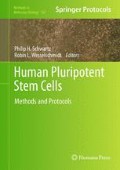Abstract
Culturing human embryonic stem cells (hESCs) requires a significant commitment of time and resources. It takes weeks to establish a culture, and the cultures require daily attention. Once hESC cultures are established, they can, with skill and the methods described, be kept in continuous culture for many years. hESC lines were originally derived using very similar culture medium and conditions as those developed for the derivation and culture of mouse ESC lines. However, these methods were suboptimal for hESCs and have evolved considerably in the years since the first hESC lines were derived. Compared with mouse ESCs, hESCs are very difficult to culture – they grow slowly, and most importantly, since we have no equivalent assays for germline competence, we cannot assume that the cells that we have in our culture dishes are either stable or pluripotent. This makes it far more critical to assay the cells frequently using the characterization methods, such as karyotyping, immunocytochemistry, gene expression analysis, and flow cytometry, provided in this manual.
Access this chapter
Tax calculation will be finalised at checkout
Purchases are for personal use only
References
Bongso, A., Fong, C.Y., Ng, S.C., and Ratnam, S. (1994) Isolation and culture of inner cell mass cells from human blastocysts. Hum Reprod. 9, 2110–7.
Thomson, J.A., Itskovitz-Eldor, J., Shapiro, S.S., Waknitz, M.A., Swiergiel, J.J., and Marshall, V.S., et al. (1998) Embryonic stem cell lines derived from human blastocysts. Science. 282, 1145–7.
Müller, F.J., Laurent, L.C., Kostka, D., Ulitsky, I., Williams, R., Lu, C., Park, I.H., Rao, M.S., Shamir, R., Schwartz, P.H., Schmidt, N.O., and Loring, J.F. (2008) Regulatory networks define phenotypic classes of human stem cell lines. Nature. 455, 401–5.
Mitalipova, M.M., Rao, R.R., Hoyer, D., Jones, K., Johnson, J., Dalton, S., Meisner, L., and S.L. Stice. (2005) Preserving the genetic integrity of human embryonic stem cell lines. Nature Biotechnology. 23, 19–20.
Amit, M., Margulets, V., Segev, H., Shariki, K., Laevsky, I., Coleman, R., and Itskovitz-Eldor, J. (2003) Human Feeder Layers for Human Embryonic Stem Cells. Biology of Reproduction. 68, 2150–6.
Heng, B.C., Ye, C.P., Liu, H., Toh, W.S., Rufaihah, A.J., Yang, Z., Bay, B.H., Ge, Z., Ouyang, H.W., Lee, E.H., and Cao, T. (2006) Loss of viability during freeze-thaw of intact and adherent human embryonic stem cells with conventional slow-cooling protocols is predominantly due to apoptosis rather than cellular necrosis. Journal of Biomedical Science. 13, 433–45.
Bajpai, R., Lesperance, J., Kim, M., and Terskikh, A.V. (2007) Efficient propagation of single cells accutase-dissociated human embryonic stem cells. Molecular Reproduction and Development. 75, 818–27.
Watanabe, K., Ueno, M., Kamiya, D., Nishiyama, A. Matsumura, M., Wataya, T., Takahashi, J.B., Nishikawa, S., Nishikawa, S., Muguruma, K., and Sasai, Y. (2007) A ROCK inhibitor permits survival of dissociated human embryonic stem cells. Nature Biotechnology 25, 681–6.
Acknowledgments
This work has been funded by the National Institutes of Health (T15HL074286, R21MH087925, R01HD059967). The NCI Preclinical Repository supplied FGF-2. We would also like to recognize the contributions of Chris Stubban, Rodolfo Gonzalez, Richard Pepple, Heather Maxwell, and Nicole Sheridan in the production of these protocols.
Author information
Authors and Affiliations
Corresponding author
Editor information
Editors and Affiliations
Rights and permissions
Copyright information
© 2011 Springer Science+Business Media, LLC
About this protocol
Cite this protocol
Schwartz, P.H., Brick, D.J., Nethercott, H.E., Stover, A.E. (2011). Traditional Human Embryonic Stem Cell Culture. In: Schwartz, P., Wesselschmidt, R. (eds) Human Pluripotent Stem Cells. Methods in Molecular Biology, vol 767. Humana Press. https://doi.org/10.1007/978-1-61779-201-4_8
Download citation
DOI: https://doi.org/10.1007/978-1-61779-201-4_8
Published:
Publisher Name: Humana Press
Print ISBN: 978-1-61779-200-7
Online ISBN: 978-1-61779-201-4
eBook Packages: Springer Protocols

